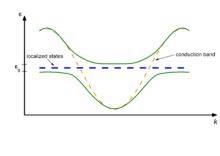Kondo insulator



In solid-state physics, Kondo insulators (also referred as Kondo semiconductors and heavy fermion semiconductors) are understood as materials with strongly correlated electrons, that open up a narrow band gap (in the order of 10 meV) at low temperatures with the chemical potential lying in the gap, whereas in heavy fermions the chemical potential is located in the conduction band. The band gap opens up at low temperatures due to hybridization of localized electrons (mostly f-electrons) with conduction electrons, a correlation effect known as the Kondo effect. As a consequence, a transition from metallic behavior to insulating behavior is seen in resistivity measurements. The band gap could be either direct or indirect. Most studied Kondo insulators are FeSi, Ce3Bi4Pt3, SmB6, YbB12, and CeNiSn.
Historical overview
In 1969, Menth et al. found no magnetic ordering in SmB6 down to 0.35 K and a change from metallic to insulating behavior in the resistivity measurement with decreasing temperature. They interpreted this phenomenon as a change of the electronic configuration of Sm.[1]
Gabriel Aeppli and Zachary Fisk found a descriptive way to explain the physical properties of Ce3Bi4Pt3 and CeNiSn in 1992. They called the materials Kondo insulators, showing Kondo lattice behavior near room temperature, but becoming semiconducting with very small energy gaps (a few Kelvin to a few tens of Kelvin) when decreasing the temperature.[2]
Transport properties
At high temperatures the localized f-electrons form independent local magnetic moments. According to the Kondo effect, the dc-resistivity of Kondo insulators shows a logarithmic temperature-dependence. At low temperatures, the local magnetic moments are screened by the sea of conduction electrons, forming a so-called Kondo resonance. The interaction of the conduction band with the f-orbitals results in a hybridization and an energy gap . If the chemical potential lies in the hybridization gap, an insulating behavior can be seen in the dc-resistivity at low temperatures.
References
- Heavy Fermions: Electrons at the Edge of Magnetism, Piers Coleman, Handbook of Magnetism and Advanced Magnetic Materials, 2007, Vol. 1, http://arxiv.org/abs/cond-mat/0612006v3
- Heavy fermion semiconductors, Peter S. Riseborough, Advances in physics, 2000, Vol. 49, No. 3, 257-320